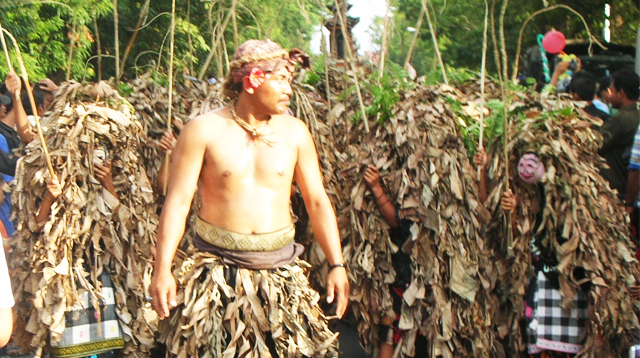- TRUNYAN community has a unique tradition known as the barong brutuk usually performed by 21 young dancers
- This sacred dance is only performed on the temple Ngusaba ceremony at Pancering Jagat Temple at local village
In Balinese cultural traditions, there are many kinds of barong or sacred mythological figures. This figure is shown in the form of various four-legged animals, such as lions, wild boars or the like. This has something to do with seven universal elements of culture, namely the religious system and artistic.
Trunyan Village in Kintamani, for instance, as one of the traditional villages in Bali, has a unique sacred barong tradition and is very different from other types of barong, the name is barong brutuk.
Barong brutuk
Balinese Hindus believe that barong brutuk is a symbol of the ruler of Trunyan Village. In addition, this barong is also believed to symbolize the meeting of men (Ratu Sakti Pancering Jagat) and women (Ida Ratu Ayu Pingit Dalem) in accordance with the concepts of Purusha and Pradhana in Hinduism.
This barong tradition also provides the younger generation with the knowledge on how to maintain social relationship and harmony as the ancestors did. It is indicated by the roles of barong brutuk masks such as the king of brutuk, queen of brutuk, vice governor, elder sister of the queen and these roles are marked off with young coconut leaf ornament on the head of the dancers. The others are named unen-unen (subjects).
Physically, this barong brutuk hair is made from dried banana leaves (kraras) and will be put on from the head to the body. Finally, each dancer puts on a mask with a primitive style while carrying a whip.
Performance
Usually, the barong brutuk dance is performed by 21 young men. Before performing, they are quarantined or undergoing purification for 42 days in the temple area. During the quarantine period, they are not allowed to leave the temple area and have sex with women. Besides, they are not allowed to gamble, drink liquors or alcoholic drinks and consume drugs.
During the quarantine period, they learned kidung (holy chants) and collected dried banana leaves and then knit them with rope and banana petals to make three kinds of costumes to be worn on the waist, shoulders and neck, and a leaf ornament for the head.
As a sacred art, the Barong Brutuk at Trunyan Village is only performed at Ngusaba ceremony at Pancering Jagat Temple at Trunyan Village falling on full moon of the fourth month in Balinese calendar (around October).
The performance starts in the morning and the dancers run while surrounding the temple compound wall for three times while waving whips that can generate a shrill sound towards the audience (ceremony participants). It is said, the whip of barong brutuk was originally used in relation to the spread of smallpox and other skin diseases at Trunya Village. At that time, people healed the disease by whip to result in bleeding wound and finally dried out. On that account, local people believe that the whip finally gave recovery and safety.
Temple priests then chant prayers and put offerings while being attended by the whole brutuk families. They all surround the temple wall compound.
Meanwhile, the participants (the audience) compete to take the loose banana leaf costumes. According to their belief, the scattered costumes will be spread around the plantation area for the sake of fertility.
At the end of the performance in the afternoon, all the dancers of barong brutuk will put off their mask and costumes. After that, they take a bath in the lake. Having such made performance, they say prayers together and have communal meals (magibung).
Where is Trunyan Village? This village is located on the edge of Lake Batur, Kintamani, Bangli. To reach this village, visitors can take the land route or ride a boat from the Kedisan pier.











